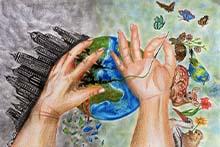Uncovering Indo-Jamaican Stories
Preserving Cultural Heritage, Identity, & Memory
By Michael A. Henry |
MARCH 3, 2022

What is the definition of Indo-Jamaican? You may have never heard the term-before. Indo-Jamaicans are descendants of those who came or were brought from the Indian subcontinent to Jamaica immediately following the 1833 abolition of slavery in the British Empire. When a new system called indentureship was introduced, bonded laborers from India were transported to nineteen British overseas territories in Asia, Africa, and the Caribbean to fill the labor shortage created by the departure of former slaves from plantations. Their recruitment began in 1834, and ended on March 20, 1917. It is estimated that over two million people were indentured laborers during this period. For 72 years, from 1845-1917, 37,027 Indians were indentured to Jamaica, my ancestors were among them. The system of indentureship ultimately shaped the history and culture of Jamaica through food, music, sports, business, and religion, creating a small yet vibrant Indo-Jamaican society. Due to various economic, political, and social factors Jamaica has experienced out migration with the Indo-Jamaican community becoming dispersed to the United Kingdom, Canada, the United States and beyond.
In the United States, May is recognized as Asian American and Pacific Islander (AAPI) Heritage Month in celebration of the contributions that generations of AAPIs have made to American history, society, and culture. As someone of Indo-Jamaican descent who did not see Indo-Jamaican representation outside of my family it’s always been a difficult month to celebrate. A few years ago, I went on a quest to find any archival information highlighting Indo-Jamaican migration to the United States, so I could acknowledge and celebrate that my people have been here for years.
To my surprise, the United States National Archives contained microfiche records of temporary importation of Jamaican agricultural workers into the U.S. during World War II by the War Food Administration. Before me was a passenger list of the U.S.A.T. General George S. Simonds voyage to Port Everglades, Florida in April 1945, almost one hundred years after the first Indian indentured laborers arrived in Jamaica under the British Indian Indenture system. On the passenger list these thirty men were listed as nationals of “Jamaica British West Indies” and their race as “East Indian.” Without even looking at the race column I immediately recognized many of the names as being those of Indian families that my grandparents spoke of from our rural area of Clarendon, Jamaica – Bagalue, Baccus, Bassaragh, Maragh, Mahabeer, Stewart, and Badwah. Seeing Badwah surprised me the most since my Great Grandmother is a Badwah descendant and we’re believed to be the only Badwah family on the island.




As a SAADA Archival Creators Fellow, I will document the oral histories of Indo-Jamaicans in the United States, I hope to gather migration stories and archival images that document the representations of identity and culture, including images of food recipes, family photos, musical traditions, and representations of various religious affiliations and practices stemming from the traditions of Hinduism, Islam, and Christianity. Questions of representation and visibility have awakened in me a desire to document the diverse stories of my small Indo-Jamaican community. Our lives have not yet been fully explored by academics and social scientists, and our stories may otherwise go untold. If you are interested in sharing your images that tell your story as an Indo-Jamaican, please reach out to IJS@saada.org.
This project is dedicated to my ancestors, the original indentures of the Moonasingh & Paul families, that crossed the Kālā Pānī from India to Jamaica in the British West Indies and now their kin spread across the global south diaspora.


Michael A. Henry is passionate about cultural heritage and based in South Florida with a professional career in financial services. His fellowship project will collect oral histories, migration stories, and cultural artifacts of Indo-Jamaican experiences and culture. This project hopes to broaden the discourse around the South Asian American diaspora to provide representation for minority subgroups. The Archival Creators Fellowship Program is made possible with grants from The Andrew W. Mellon Foundation and the Institute of Museum and Library Services (IMLS).







